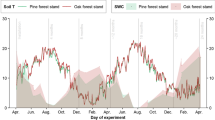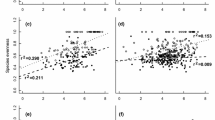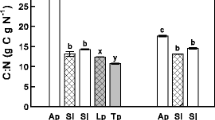Abstract
Litter decomposition is central to ecosystem functioning and depends, under constant abiotic conditions, on litter quality and decomposer activity. During the assembly of a plant community following disturbance, litter quality is expected to decrease, due to an increasing proportion of resource-conservative species, whereas decomposer activity is expected to increase, due to the establishment of decomposer populations and their response to local vegetation (“home-field advantage”, HFA). To date, the combined effect of these processes remains poorly understood. We studied 27 seminatural grasslands in western France, ranging from 1 to 25 years since last cultivation. We measured the functional composition of plant communities using litter traits (specific leaf area, leaf dry matter content, C/N ratio, phenolics), characterized the entire community of decomposers (macrofauna, mesofauna, microbes) and performed reciprocal litter transplants to quantify HFA. We found that, overall, decomposition was rapid, and HFA was not evident. While there was substantial among-grassland variation in decomposition and HFA, neither changed with grassland age. Litter quality and decomposer efficiency also remained, overall, unchanged. However, grassland age determined all measured litter traits and caused soil microbial C/N ratio to decline. Although these changes impacted decomposition individually, together they canceled out each other, resulting in constant decomposition across the chronosequence. Our results suggest that processes driving decomposition differ during grassland succession and suggest that HFA may be lower in communities with high litter quality. Moreover, simultaneous assembly processes have opposing and therefore stabilizing effects on decomposition, possibly explaining the outstanding resilience of primary production in temperate grassland ecosystems.



Similar content being viewed by others
References
Austin AT, Vivanco L, González-Arzac A, Pérez LI. 2014. There’s no place like home? An exploration of the mechanisms behind plant litter-decomposer affinity in terrestrial ecosystems. New Phytologist 204:307–14.
Bakker MA, Carreño-Rocabado G, Poorter L. 2011. Leaf economics traits predict litter decomposition of tropical plants and differ among land use types: Leaf economics traits and decomposition. Functional Ecology 25:473–83.
Barbe L, Jung V, Prinzing A, Bittebiere A-K, Butenschoen O, Mony C. 2017. Functionally dissimilar neighbors accelerate litter decomposition in two grass species. New Phytologist 214:1092–102.
Bardgett RD, van der Putten WH. 2014. Belowground biodiversity and ecosystem functioning. Nature 515:505–11.
Berlese A. 1905. Apparicchio per raccogliere presto ed in gran numero di piccolo artropodi. Redia 2: 85–89.
Bernays EA, Driver GC, Bilgener M. 1989. Herbivores and plant tannins. Advances in ecological research 19:263–302.
Bouché MB. 1972. Lombriciens de France: écologie et systématique, Paris.
Bouché MB. 1977. Stratégies lombriciennes. Ecological Bulletins 25:122–32.
Briske DD. 1996. Strategies of plant survival in grazed systems: a functional interpretation, in The Ecology and Management of Grazing Systems, edited by J Hodgson and AW Illius, pp. 37–68, CAB International.
Brookes PC, Landman A, Pruden G, Jenkinson DS. 1985. Chloroform fumigation and the release of soil nitrogen: a rapid direct extraction method to measure microbial biomass nitrogen in soil. Soil Biology and Biochemistry 17:837–42.
Caro G, Decaëns T, Lecarpentier C, Mathieu J. 2013. Are dispersal behaviours of earthworms related to their functional group? Soil Biology and Biochemistry 58:181–7.
Cebrian J. 1999. Patterns in the fate of production in plant communities. The American Naturalist 154:449–68.
Chauvat M, Wolters V, Dauber J. 2007. Response of collembolan communities to land-use change and grassland succession. Ecography 30:183–92.
Cluzeau D, Guernion M, Chaussod R, Martin-Laurent F, Villenave C, Cortet J, Ruiz-Camacho N, Pernin C, Mateille T, Philippot L, Bellido A, Rougé L, Arrouays D, Bispo A, Pérès G. 2012. Integration of biodiversity in soil quality monitoring: Baselines for microbial and soil fauna parameters for different land-use types. European Journal of Soil Biology 49:63–72.
Cornelissen JHC, Pérez-Harguindeguy N, Diaz S, Grime JP, Marzano B, Cabido M, Vendramini F, Cerabolini B. 1999. Leaf structure and defence control litter decomposition rate across species and life forms in regional floras on two continents. New Phytologist 143:191–200.
Cornelissen JHC, Thompson K. 1997. Functional leaf attributes predict litter decomposition rate in herbaceous plants. New Phytologist 135:109–14.
Coûteaux M-M, Bottner P, Berg B. 1995. Litter decomposition, climate and litter quality. Trends in Ecology & Evolution 10:63–6.
Cramer VA, Hobbs RJ, Standish RJ. 2008. What’s new about old fields? Land abandonment and ecosystem assembly. Trends in Ecology & Evolution 23:104–12.
Decaëns T, Margerie P, Aubert M, Hedde M, Bureau F. 2008. Assembly rules within earthworm communities in North-Western France–A regional analysis. Applied Soil Ecology 39:321–35.
Eisenhauer N, Reich PB, Isbell F. 2012. Decomposer diversity and identity influence plant diversity effects on ecosystem functioning. Ecology 93:2227–40.
Folin O, Denis W. 1915. A colorimetric method for the determination of phenols (and phenol derivatives) in urine. Journal of Biological Chemistry 22:305–8.
Freschet GT, Aerts R, Cornelissen JHC. 2012. Multiple mechanisms for trait effects on litter decomposition: moving beyond home-field advantage with a new hypothesis: Substrate-matrix quality interactions in decay. Journal of Ecology 100:619–30.
Garnier E, Cortez J, Billès G, Navas M-L, Roumet C, Debussche M, Laurent G, Blanchard A, Aubry D, Bellmann A, Neill C, Toussaint J-P. 2004. Plant functional markers capture ecosystem properties during secondary succession. Ecology 85:2630–7.
Gessner MO, Swan CM, Dang CK, McKie BG, Bardgett RD, Wall DH, Hättenschwiler S. 2010. Diversity meets decomposition. Trends in ecology & evolution 25:372–80.
Gießelmann UC, Martins KG, Brändle M, Schädler M, Marques R, Brandl R. 2011. Lack of home-field advantage in the decomposition of leaf litter in the Atlantic Rainforest of Brazil. Applied Soil Ecology 49:5–10.
Hättenschwiler S, Vitousek PM. 2000. The role of polyphenols in terrestrial ecosystem nutrient cycling. Trends in Ecology & Evolution 15:238–43.
Hülsmann A, Wolters V. 1998. The effects of different tillage practices on soil mites, with particular reference to Oribatida. Applied Soil Ecology 9:327–32.
Hoyos-Santillan J, Lomax BH, Turner BL, Sjögersten S. 2018. Nutrient limitation or home field advantage: Does microbial community adaptation overcome nutrient limitation of litter decomposition in a tropical peatland? Journal of Ecology 106:1558–69.
Kahmen S, Poschlod P. 2004. Plant functional trait responses to grassland succession over 25 years. Journal of Vegetation Science 15:21–32.
Keiser AD, Keiser DA, Strickland MS, Bradford MA. 2014. Disentangling the mechanisms underlying functional differences among decomposer communities. Journal of Ecology 102:603–9.
Li YB, Li Q, Yang JJ, Lü XT, Liang WJ, Han XG, Bezemer TM. 2017. Home-field advantages of litter decomposition increase with increasing N deposition rates: a litter and soil perspective. Functional Ecology 31:1792–801.
Lu W, Liu N, Zhang Y, Zhou J, Guo Y, Yang X. 2017. Impact of vegetation community on litter decomposition: Evidence from a reciprocal transplant study with 13C labeled plant litter. Soil Biology and Biochemistry 112:248–57.
Makkonen M, Berg MP, Handa IT, Hättenschwiler S, van Ruijven J, van Bodegom PM, Aerts R. 2012. Highly consistent effects of plant litter identity and functional traits on decomposition across a latitudinal gradient. Ecology Letters 15:1033–41.
Mazzanti A, Lemaire G, Gastal F. 1994. The effect of nitrogen fertilization upon the herbage production of tall fescue swards continuously grazed with sheep. II-herbage consumption. Grass and Forage Science 49:352–9.
Milcu A, Manning P. 2011. All size classes of soil fauna and litter quality control the acceleration of litter decay in its home environment. Oikos 120:1366–70.
Milcu A, Partsch S, Scherber C, Weisser WW, Scheu S. 2008. Earthworms and legumes control litter decomposition in a plant diversity gradient. Ecology 89:1872–82.
Pakeman RJ, Eastwood A, Scobie A. 2011. Leaf dry matter content as a predictor of grassland litter decomposition: a test of the “mass ratio hypothesis”. Plant and Soil 342:49–57.
Pakeman RJ, Quested HM. 2007. Sampling plant functional traits: What proportion of the species need to be measured? Applied Vegetation Science 10:91–6.
Palozzi JE, Lindo Z. 2018. Are leaf litter and microbes team players? Interpreting home-field advantage decomposition dynamics. Soil Biology and Biochemistry 124:189–98.
Paul EA, Clark FE. 1996. Soil Microbiology and Biochemistry. California: Academic Press. p 340p.
Perez G, Aubert M, Decaëns T, Trap J, Chauvat M. 2013. Home-field advantage: a matter of interaction between litter biochemistry and decomposer biota. Soil Biology and Biochemistry 67:245–54.
Pérez-Harguindeguy N, Diaz S, Cornelissen JHC, Vendramini F, Cabido M, Castellanos A. 2000. Chemistry and toughness predict leaf litter decomposition rates over wide spectrum of functional types and taxa in central Argentina. Plant and Soil 218:21–30.
Pérez-Harguindeguy N, Díaz S, Garnier E, Lavorel S, Poorter H, Jaureguiberry P, Bret-Harte MS, Cornwell WK, Craine JM, Gurvich DE, Urcelay C, Veneklaas EJ, Reich PB, Poorter L, Wright IJ, Ray P, Enrico L, Pausas JG, de Vos AC, Buchmann N, Funes G, Quétier F, Hodgson JG, Thompson K, Morgan HD, ter Steege H, Sack L, Blonder B, Poschlod P, Vaieretti MV, Conti G, Staver AC, Aquino S, Cornelissen JHC. 2013. New handbook for standardised measurement of plant functional traits worldwide. Australian Journal of Botan 61:167–234.
Petersen H, Luxton M. 1982. A comparative analysis of soil fauna populations and their role in decomposition processes. Oikos 39:288–388.
Ponge J-F, Gillet S, Dubs F, Fedoroff E, Haese L, Sousa JP, Lavelle P. 2003. Collembolan communities as bioindicators of land use intensification. Soil Biology and Biochemistry 35:813–26.
Ponge J-F, Pérès G, Guernion M, Ruiz-Camacho N, Cortet J, Pernin C, Villenave C, Chaussod R, Martin-Laurent F, Bispo A, Cluzeau D. 2013. The impact of agricultural practices on soil biota: A regional study. Soil Biology and Biochemistry 67:271–84.
Quested H, Eriksson O, Fortunel C, Garnier E. 2007. Plant traits relate to whole-community litter quality and decomposition following land use change. Functional Ecology 21:1016–26.
R Core Team (2016) R: A language and environment for statistical computing. R Foundation for Statistical Computing, Vienna, Austria. URL https://www.R-project.org/.
Robertson GP. 1999. Standard soil methods for long-term ecological research, Vol. 2Oxford: Oxford University Press.
Sanaullah M, Chabbi A, Lemaire G, Charrier X, Rumpel C. 2010. How does plant leaf senescence of grassland species influence decomposition kinetics and litter compounds dynamics? Nutrient Cycling in Agroecosystems 88:159–71.
Santiago LS. 2007. Extending the leaf economics spectrum to decomposition: evidence from a tropical forest. Ecology 88:1126–31.
Santonja M, Fernandez C, Gauquelin T, Baldy V. 2015. Climate change effects on litter decomposition: intensive drought leads to a strong decrease of litter mixture interactions. Plant and Soil 393:69–82.
Santonja M, Foucault Q, Rancon A, Gauquelin T, Fernandez C, Baldy V, Mirleau P. 2018. Contrasting responses of bacterial and fungal communities to plant litter diversity in a Mediterranean oak forest. Soil Biology and Biochemistry 125:27–36.
Swift MJ, Heal OW, Anderson JM. 1979. Decomposition in terrestrial ecosystems, Vol. 5Berkeley: University of California Press.
Thomas Z, Abbott BW, Troccaz O, Baudry J, Pinay G. 2016. Proximate and ultimate controls on carbon and nutrient dynamics of small agricultural catchments. Biogeosciences 13:1863–75.
Vance ED, Brookes PC, Jenkinson DS. 1987. An extraction method for measuring soil microbial biomass C. Soil Biology and Biochemistry 19:703–7.
Van Elsas JD, Trevors JT, Jansson JK, Nannipieri P. 2006. Modern soil microbiology. Florida: CRc Press. p 683p.
Veen GFC, Freschet GT, Ordonez A, Wardle DA. 2015. Litter quality and environmental controls of home-field advantage effects on litter decomposition. Oikos 124:187–95.
Veen GFC, Keiser AD, van der Putten WH, Wardle DA. 2018. Variation in home-field advantage and ability in leaf litter decomposition across successional gradients. Functional Ecology 32:1563–74.
Violle C, Garnier E, Lecoeur J, Roumet C, Podeur C, Blanchard A, Navas M-L. 2009. Competition, traits and resource depletion in plant communities. Oecologia 160:747–55.
Wardle DA. 1992. A comparative assessment of factors which influence microbial biomass carbon and nitrogen levels in soil. Biological Reviews 67:321–58.
Wright IJ, Reich PB, Westoby M, Ackerly DD, Baruch Z, Bongers F, Cavender-Bares J, Chapin T, Cornelissen JHC, Diemer M, Flexas J, Garnier E, Groom PK, Gulias J, Hikosaka K, Lamont BB, Lee T, Lee W, Lusk C, Midgley JJ, Navas M-L, Niinemets Ü, Oleksyn J, Osada N, Poorter H, Poot P, Prior L, Pyankov VI, Roumet C, Thomas SC, Tjoelker MG, Veneklass EJ, Villar R. 2004. The worldwide leaf economics spectrum. Nature 428:821–7.
Wright S. 1934. The method of path coefficients. The Annals of Mathematical Statistics 5:161–215.
Acknowledgements
We thank Aurélien Pierre for measuring the soil microbial C/N ratio, and we acknowledge Albin Fertil, Daniel Cylly, André Bastin, Valentin Blanchard, Romain Georges, Olivier Jambon, Jérémy Guy, Nathan Vannier and Stéphanie Llopis for help with sampling earthworms. We are very grateful to Mathilde Le Moing for earthworm identification. We thank Jean-Sébastien Pierre for helping with the SAS statistical analyses. The work benefited from the support of the LTER site “ZA Armorique”.
Author information
Authors and Affiliations
Corresponding author
Additional information
Authors Contributions
All authors contributed to the conception of the experiment and the data collection. LB analyzed the data, with help of AP, CM and VJ. LB wrote the manuscript, with help of all authors.
Electronic Supplementary Material
Below is the link to the electronic supplementary material.
Rights and permissions
About this article
Cite this article
Barbe, L., Prinzing, A., Mony, C. et al. Opposing Effects of Plant-Community Assembly Maintain Constant Litter Decomposition over Grasslands Aged from 1 to 25 Years. Ecosystems 23, 124–136 (2020). https://doi.org/10.1007/s10021-019-00392-8
Received:
Accepted:
Published:
Issue Date:
DOI: https://doi.org/10.1007/s10021-019-00392-8




